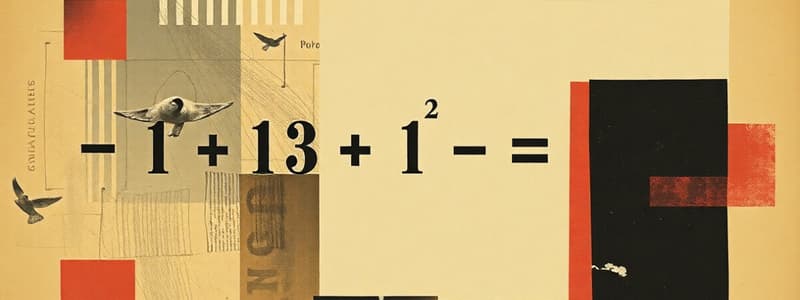Podcast
Questions and Answers
If 2.5 is multiplied by 100, what is the result?
If 2.5 is multiplied by 100, what is the result?
- 250 (correct)
- 2.5
- 25
- 2500
Which property of multiplication states that the order of the factors does not affect the product?
Which property of multiplication states that the order of the factors does not affect the product?
- Distributive Property
- Identity Property
- Commutative Property (correct)
- Associative Property
Calculate 15.2 multiplied by 0.007. Which step ensures the correct placement of the decimal point?
Calculate 15.2 multiplied by 0.007. Which step ensures the correct placement of the decimal point?
- Multiply the decimal places.
- Subtract the decimal places.
- Add decimal places from both numbers. (correct)
- Ignore decimal places.
When multiplying 3 x 4 and 4 x 3, what property of multiplication is being demonstrated?
When multiplying 3 x 4 and 4 x 3, what property of multiplication is being demonstrated?
What is the result of multiplying any number by zero?
What is the result of multiplying any number by zero?
What is the proper multiplication of 2.5 and 1.2 after multiplying as whole numbers?
What is the proper multiplication of 2.5 and 1.2 after multiplying as whole numbers?
Which example illustrates the Distributive Property?
Which example illustrates the Distributive Property?
Flashcards
What is multiplication?
What is multiplication?
A fundamental arithmetic operation representing repeated addition.
What is the commutative property of multiplication?
What is the commutative property of multiplication?
The order of numbers being multiplied doesn't change the result. For example, 3 x 4 = 4 x 3.
What is the associative property of multiplication?
What is the associative property of multiplication?
The way you group the numbers being multiplied doesn't affect the answer. For example, (2 x 3) x 4 = 2 x (3 x 4).
What is the distributive property of multiplication?
What is the distributive property of multiplication?
Signup and view all the flashcards
How do you multiply decimals?
How do you multiply decimals?
Signup and view all the flashcards
How do you multiply by powers of 10?
How do you multiply by powers of 10?
Signup and view all the flashcards
What is the identity property of multiplication?
What is the identity property of multiplication?
Signup and view all the flashcards
What is the zero property of multiplication?
What is the zero property of multiplication?
Signup and view all the flashcards
Study Notes
Multiplication
- Multiplication is a fundamental arithmetic operation representing repeated addition. It's a shorthand for repeated addition.
- Example: 3 x 4 = 3 + 3 + 3 + 3 = 12.
- The 'x' symbol represents multiplication.
- Multiplication is commutative: 3 x 4 = 4 x 3.
- Multiplication is associative: (2 x 3) x 4 = 2 x (3 x 4).
- Multiplication is distributive over addition and subtraction: 2 x (3 + 5) = (2 x 3) + (2 x 5).
Multiplication by Decimals
- Multiplying decimals follows the same principles as whole numbers, but requires careful placement of the decimal point.
- Multiply the numbers as if they were whole numbers.
- Count the total number of decimal places in both factors.
- Place the decimal point in the product so that it has the same number of decimal places as the total count in the factors.
Examples of Multiplying Decimals
-
Example: 2.5 x 1.2
- Multiply as whole numbers: 25 x 12 = 300
- Count decimal places: 2.5 (1), 1.2 (1), total = 2.
- Place decimal point: 3.00 or 3.
-
Example: 0.03 x 0.4
- Multiply as whole numbers: 3 x 4 = 12
- Count decimal places: 0.03 (2), 0.4 (1), total = 3.
- Place decimal point: 0.012
-
Example: 15.2 x 0.007
- Multiply as whole numbers: 152 x 7 = 1064
- Count decimal places: 15.2 (1), 0.007 (3), total = 4.
- Place decimal point: 0.1064
Multiplying Decimals with Larger Numbers
- The method remains the same for larger decimal numbers. Precise decimal placement is crucial.
Multiplication Properties
- Commutative Property: a x b = b x a
- Associative Property: (a x b) x c = a x (b x c)
- Distributive Property: a x (b + c) = (a x b) + (a x c)
- Identity Property: a x 1 = a
- Zero Property: a x 0 = 0
Multiplication with Factors of 10
- Multiplying by factors of 10 (10, 100, 1000, etc.) involves moving the decimal point to the right by the number of zeros in the factor.
- Example: 2.5 x 10 = 25, 2.5 x 100 = 250, 2.5 x 1000 = 2500
Studying That Suits You
Use AI to generate personalized quizzes and flashcards to suit your learning preferences.




